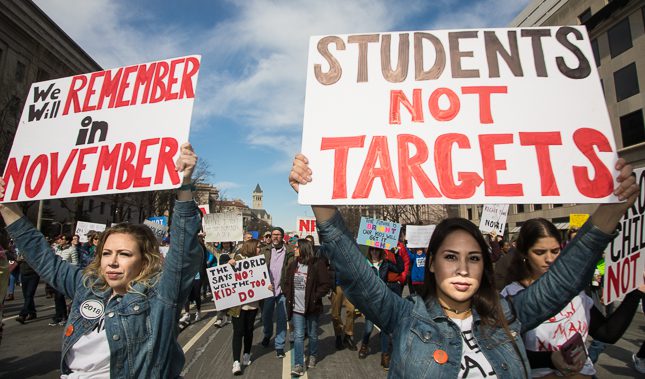City of Marches: Where Else But D.C.?
By • April 4, 2018 0 331

Two Saturdays ago, this city witnessed what may have been — depending which estimate you believe — the largest U.S. demonstration of any sort ever. The March for Our Lives along Pennsylvania Avenue on March 24, led by the survivors of the mass shooting at Marjory Stoneman Douglas High School in Florida, drew at least 250,000 participants, and quite possibly 500,000 or 800,000.
Many of the protesters (there was no room to actually march) were passionate and very determined teenagers, who threatened legislators with ballot-box retribution if they did not act on gun control and reform.
Doubled up with the Women’s March, which drew comparable numbers the day after Donald Trump’s inauguration — and similar marches across the country and world — the events drew nationwide attention, raising hopes that change was possible and that the iron grip on the gun issue by the National Rifle Association and SecondAmendment advocates could be broken or at least loosened.
But the March for Our Lives also raised another question. How do we feel — as residents, not as political partisans — about the fact that our city, where we live, shop, sleep, travel, work, holds the status of Demonstration Central, for many years now, going back as far as the end of the 19th century.
Demonstrations, especially those on such a large scale, mean that, for however long they last, our lives will be disrupted, our travels will be rerouted; you buy groceries the night before, you decide whether to go (and not get back for a long time) or to watch in the comfort of your own home (on a big screen while eating pizza).
Demonstrations are also expensive, in terms of security resources deployed, overtime hours, transportation and so on. On this issue, restaurant owners and tourism officials might disagree, but demonstrations and demonstrators can be a pain to the body politic that lives here, also presenting the prospect of violent clashes when divisive issues are involved.
The basic question is: Are demonstrations worth the trouble?
We’ve been down among the crowds, as have older folks who remember the ringing voice of Martin Luther King and, for that matter, 2017’s pink pussyhats, and teenagers, the Million Man March, the multitudes of anti-war demonstrators (Vietnam, Iraq), the solidifying of gay rights in a blissful celebration in the 1980s and 1990s, the civil rights marches and, ominously, the stories about the KKK marches in the 1920s, Coxey’s Army and the World War I veterans marching during the 1930s.
Here’s the thing: No other city, no other place beckons as a beacon of history like this city. It’s correct that people with grievances, with righteous pleas for justice, with beliefs in choice or life, should come here and plead their cause and voice their feelings. Where else, except within sight of the sage eyes of Lincoln, the monuments and stone tributes to our fallen, should people go but here?
There’s no question that the marches and demonstrations can make life difficult for a period of time. But, if you have a side and a feeling, a tingling or broken heart, there is no better place than this to be embraced by the voices of history.
We often get too wrapped up in numbers and reports from the battleground. The 1963 Civil Rights march was not the biggest ever, but every word spoken by Martin Luther King seems to have taken on lasting value, continuing to echo, so that his granddaughter could remind us of some of his words only a week ago.
What happens here will happen nowhere else, that resonant noise of voices in unison. It will happen again and soon: a march for science, a march for climate, a march for peace, a march that insists, against all pragmatism: Never Again.
Down all the avenues we hear the answers, like nowhere else.

